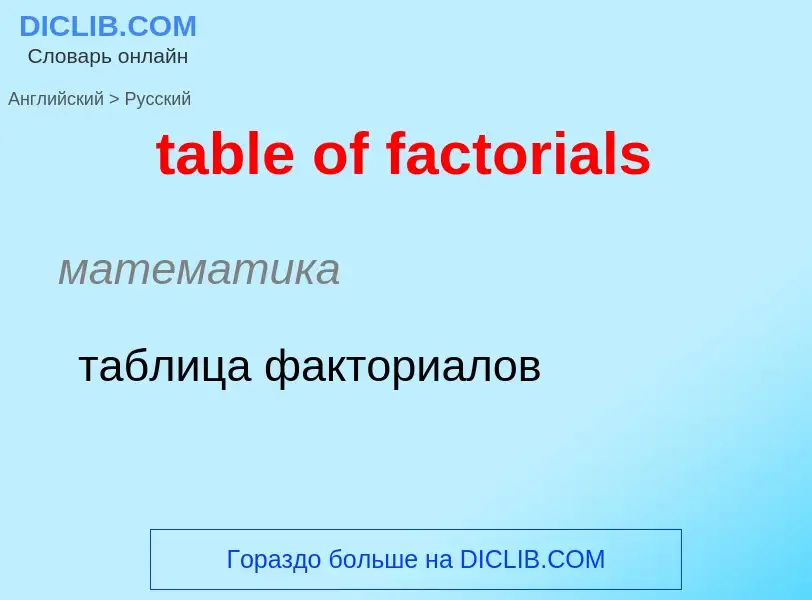Перевод и анализ слов искусственным интеллектом
На этой странице Вы можете получить подробный анализ слова или словосочетания, произведенный с помощью лучшей на сегодняшний день технологии искусственного интеллекта:
- как употребляется слово
- частота употребления
- используется оно чаще в устной или письменной речи
- варианты перевода слова
- примеры употребления (несколько фраз с переводом)
- этимология
table of factorials - перевод на русский
математика
таблица факториалов
[pi(ə)riɔdik'teib(ə)l]
общая лексика
периодическая система элементов Менделеева
химия
таблица Менделеева
математика
периодическая система
Определение
.
Википедия
In mathematics, an alternating factorial is the absolute value of the alternating sum of the first n factorials of positive integers.
This is the same as their sum, with the odd-indexed factorials multiplied by −1 if n is even, and the even-indexed factorials multiplied by −1 if n is odd, resulting in an alternation of signs of the summands (or alternation of addition and subtraction operators, if preferred). To put it algebraically,
or with the recurrence relation
in which af(1) = 1.
The first few alternating factorials are
- 1, 1, 5, 19, 101, 619, 4421, 35899, 326981, 3301819, 36614981, 442386619, 5784634181, 81393657019 (sequence A005165 in the OEIS)
For example, the third alternating factorial is 1! – 2! + 3!. The fourth alternating factorial is −1! + 2! − 3! + 4! = 19. Regardless of the parity of n, the last (nth) summand, n!, is given a positive sign, the (n – 1)th summand is given a negative sign, and the signs of the lower-indexed summands are alternated accordingly.
This pattern of alternation ensures the resulting sums are all positive integers. Changing the rule so that either the odd- or even-indexed summands are given negative signs (regardless of the parity of n) changes the signs of the resulting sums but not their absolute values.
Miodrag Zivković proved in 1999 that there are only a finite number of alternating factorials that are also prime numbers, since 3612703 divides af(3612702) and therefore divides af(n) for all n ≥ 3612702. As of 2006, the known primes and probable primes are af(n) for (sequence A001272 in the OEIS)
- n = 3, 4, 5, 6, 7, 8, 10, 15, 19, 41, 59, 61, 105, 160, 661, 2653, 3069, 3943, 4053, 4998, 8275, 9158, 11164
Only the values up to n = 661 have been proved prime in 2006. af(661) is approximately 7.818097272875 × 101578.


![hydrogen-like]] atomic orbitals showing probability density and phase (g orbitals and higher are not shown) hydrogen-like]] atomic orbitals showing probability density and phase (g orbitals and higher are not shown)](https://commons.wikimedia.org/wiki/Special:FilePath/Atomic-orbital-clouds spdf m0.png?width=200)
![Idealized order of subshell filling according to the [[Madelung rule]] Idealized order of subshell filling according to the [[Madelung rule]]](https://commons.wikimedia.org/wiki/Special:FilePath/Aufbau Principle.png?width=200)



.jpg?width=200)

.gif?width=200)



